Foaling season has arrived at the horse barns
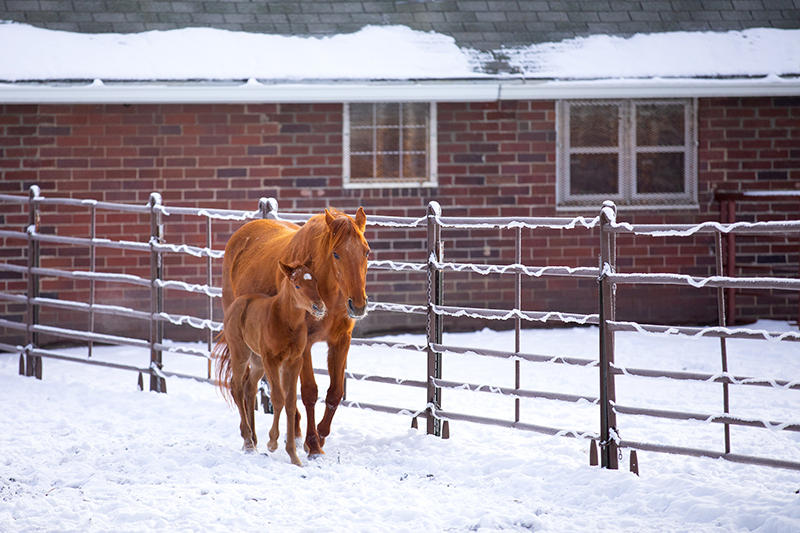
Photo by Christopher Gannon.
An 8-day-old foal cozies up to its mother for warmth (or confidence?) along a snowy corral fence Monday morning at the horse barns on the north side of campus. According to farm manager and associate teaching professor Nikki Ferwerda, about 80 foals will be born on campus between January and June; this beauty is No. 4. Keep up with the birth announcements on the barns' Facebook site.
In addition to the historic horse barns, the animal science department operates the equine learning center on Mortensen Road, west of the Hansen Agriculture Student Learning Center.
Restructured CELT focuses on campus' evolving needs
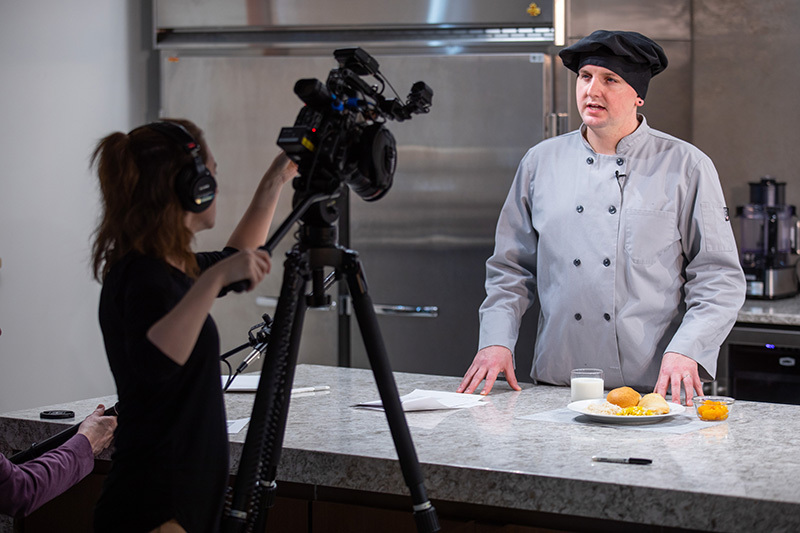
Tom Keinert, a human sciences extension program specialist, appears on camera during a video shoot in the Food Sciences Building. It is part of a 10-module, online course delivered through a video series produced with Iowa State Online. Photo by Christopher Gannon.
Sarah Francis had never developed an online course. The Iowa State Online team was working together for the first time. In less than a day, their collaboration on an online nutrition course turned into a recipe for success.
A reorganized CELT
Faculty with questions about offerings in any of CELT's four units should email celt-help@iastate.edu (not the Iowa State Online email) to ensure the right individuals address needs efficiently.
"From Jan. 1 through Jan. 20 in 2022, we had about 160 tickets through the system. For that same amount of time this year we are already at about 300 tickets," said CELT director Sara Marcketti. "I think that shows the growth of our services and faculty learning to reach out to us in the different areas."
CELT currently has about 45 employees. That includes the previous CELT team, new hires and staff in online units from the College of Agriculture and Life Sciences, the College of Human Sciences and the combined Engineering and Liberal Arts and Sciences colleges. Online curriculum decisions remain in the departments and colleges. CELT staff do not teach courses; they simply are resources to enhance in-person, online and hybrid teaching.
"We have a lot of familiar faces, so when faculty and staff interact with us, they will have deep histories with many of them," Marcketti said. "This just provides us a deeper bench available to serve campus."
Francis, associate professor of food science and human nutrition, is the principal investigator for one of four pilot projects this spring for a restructured Center for Excellence in Learning and Teaching (CELT) as it prepares to serve faculty, staff and students' online needs. CELT now consists of four units: course design and quality, enterprise instructional technology, instructor development and Iowa State Online.
Francis met for months with members of Iowa State Online staff, including professional development services manager Hiroyuki Iino and media production specialist Allison Kayser, to build the 10-module, online course delivered through a video series. It will benefit employees at hospitals, retirement communities and assisted living facilities across the country and was possible with a grant through the federally funded Nutrition and Aging Resource Center. This pilot gives Iowa State Online staff the opportunity to learn while working on a grant project.
"My research team was just in awe of what [Iowa State Online] could do, because we had no idea the amount of detail, time and creativity that went into this," said Francis of the recording session last Friday. "We quickly realized what a high-quality course this was going to be."
For Francis, success was more than just the ability to shoot effective video.
"Because of their expertise, they know the questions we wouldn't know to ask, and provide us with the learning strategies to make online learning impactful and engaging," she said.
Pilots
In addition to Francis' project, three other pilot projects are underway to help instructors and CELT staff get to know each other, anticipate instructor needs and define university-level guidelines. The four pilots touch on CELT's goals of growing online learning and supporting educators to create and deliver high quality experiences. The four are:
- Grant-funded project focused on aging and nutrition
- Microcredentialling with cybersecurity
- Program marketing and student support services with human computer interaction
- Quality Matters certification with the agronomy department's online master's program
Each pilot has a different goal: developing grant-based content, developing continuing education for working professionals -- called microcredentials -- to earn a certificate, refining courses for online delivery and earning the Quality Matters distinction. The projects were chosen, in part, to connect with multiple departments and colleges and determine internal and external processes, said assistant provost and CELT executive director Sara Marcketti. Each has one or more faculty members working with multiple CELT units.
"The pilots allow us to work through some of the services that we will be providing to campus while being able to see some of the pinch points we encounter," Marcketti said.
She said the goal is to have a finished look to Iowa State Online's offerings for faculty and potential learners by fall semester.
One unit
Iowa State Online launched Jan. 3 and brought together individuals previously working across campus (see breakout). CELT is developing a strategic plan for continued success. Marcketti shared eight goals:
- Have a high functioning CELT team and culture
- Establish a universitywide business model focused on both growth and operational efficiency
- Provide a consistent, high-quality experience, whether the class is taught in the classroom, online or in a hybrid format
- Streamline instructor support
- Ensure a seamless, high-quality experience for learners on campus, in the 99 counties across the state and anywhere in the world
- Support growth and innovation in online offerings and online students
- Develop and foster a consistent cohesive brand that elevates awareness of Iowa State’s online programs
- Leverage Iowa State's strengths as a university of science and technology to address student and employer needs
All of CELT's units can assist instructors in developing strong online courses, but Iowa State Online is the first point of contact for students. It is the central stop for students looking for more information about online education and has marketing, promoting new programs and corporate outreach among its duties. Iowa State Online director Susan Arendt emphasized the importance of the Iowa State Online website as a central stop.
You're invited: Campus celebrates George Washington Carver Day
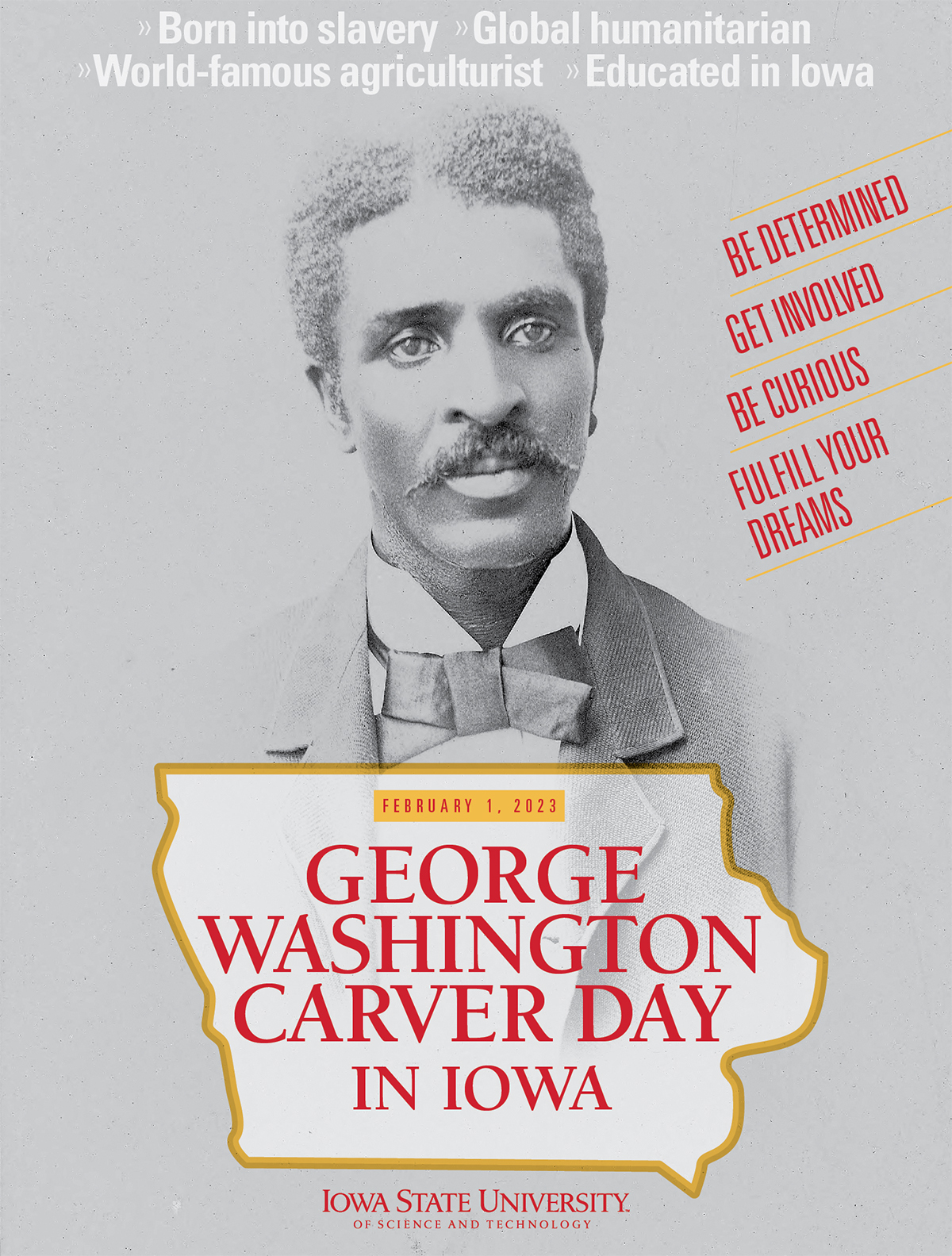
The university community will celebrate the state of Iowa's first George Washington Carver Day on Feb. 1 with a program featuring speakers from three states, student readings and Carver-inspired foods.
Free and open to the public, the celebration will be held in the Memorial Union Great Hall, with a reception starting at 5 p.m. and program beginning at 5:30 p.m. The event also will be livestreamed. Free posters and buttons marking the inaugural Carver Day in Iowa will be given away at the event. RSVPs are requested by Jan. 30.
Last June, Gov. Kim Reynolds approved Senate File 2380, an act to designate Feb. 1 each year as George Washington Carver Day in Iowa. Carver is only the third person to be recognized by the state with a day of recognition; the other two are Herbert Hoover and Norman Borlaug. Carver was Iowa State's first Black student and faculty member before leaving for a lifelong career at Tuskegee Institute (now University) in Alabama. He introduced improved farming systems and developed hundreds of food products from plants such as peanuts, sweet potatoes and others native to the southern United States. He received bachelor's (1894) and master's (1896) degrees in agricultural science from Iowa State.
Campus event
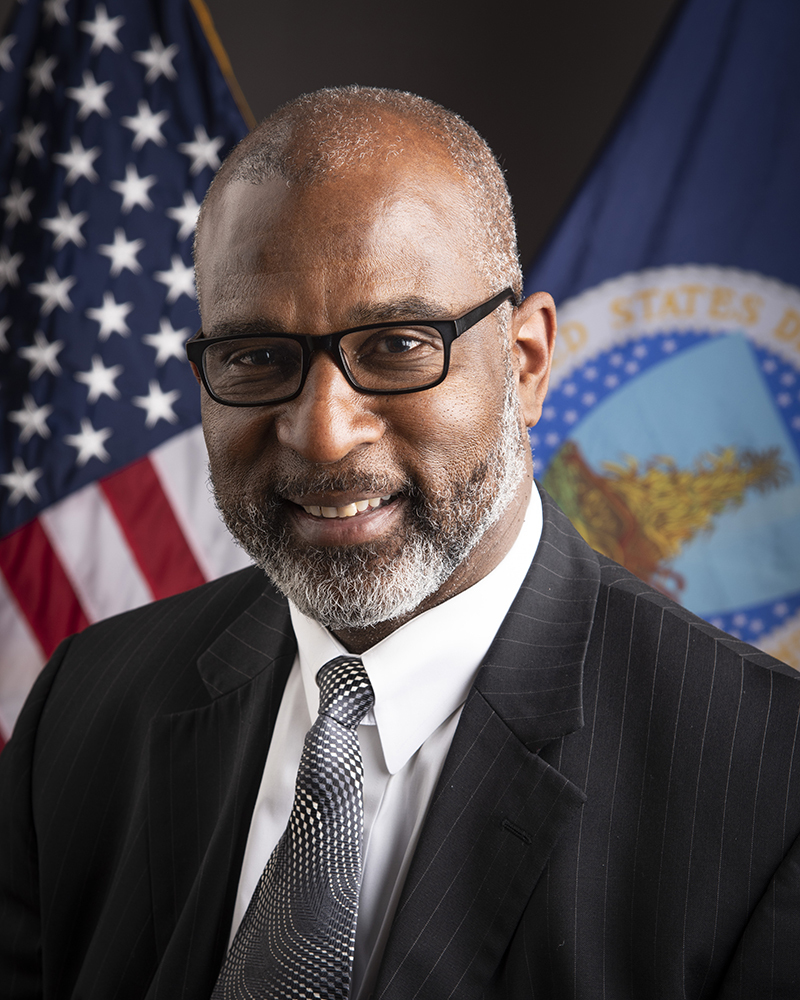
Goldmon
Alumnus Dewayne Goldmon, senior advisor for racial equity to the U.S. Secretary of Agriculture, will deliver the keynote address at the campus event. Goldmon earned his Ph.D. in agronomy (1991) at Iowa State, and was the 2020 recipient of the George Washington Carver Distinguished Service Award from the College of Agriculture and Life Sciences. The program also will feature reflections on Carver's life and legacy from:
- Wendy Wintersteen, president
- Kenneth Quinn, president emeritus, World Food Prize, and former U.S. Ambassador to Cambodia
- Marsha Kelliher, president, Simpson College, Indianola
- Olga Bolden-Tiller, dean, College of Agriculture, Environment and Nutrition Sciences, Tuskegee University
- Simon Estes, F. Wendell Miller Distinguished Artist in Residence, department of music and theatre
- Daniel Robison, Endowed Dean's Chair, College of Agriculture and Life Sciences
Throughout the program, ISU students, faculty and staff will deliver a series of readings from Carver's writings.
Learn more
A George Washington Carver Day web page includes more information on the Feb. 1 program, a link to download a poster on the first Carver Day in Iowa and other resources to learn more about Carver's life.
The pre-program reception will feature refreshments inspired by Carver's work. At 7 p.m., the concluding reception will feature Legacy ice cream produced by the ISU Creamery. A team of food science students created the flavor -- peanut butter and butterscotch ice cream with chocolate-covered rice crisps -- to honor two outstanding Iowa State alumni: Carver, who performed extensive research on peanut products, and Mildred Day, who developed Rice Krispie treats.
Program planning committee members: Wintersteen; Quinn; Robison, Theressa Cooper, assistant dean for diversity and director of the George Washington Carver Summer Research Internship Program, and Andy Zehr, director of marketing and new student programs, all in the College of Agriculture and Life Sciences; Jeff Johnson, Lora and Russ Talbot Endowed President and CEO, ISU Alumni Association; Haley Cook, strategic engagement coordinator, office of the president; and Brian Meyer, associate director for strategic communications, office of strategic relations and communications.
Workday Learning is the successor to Learn@ISU
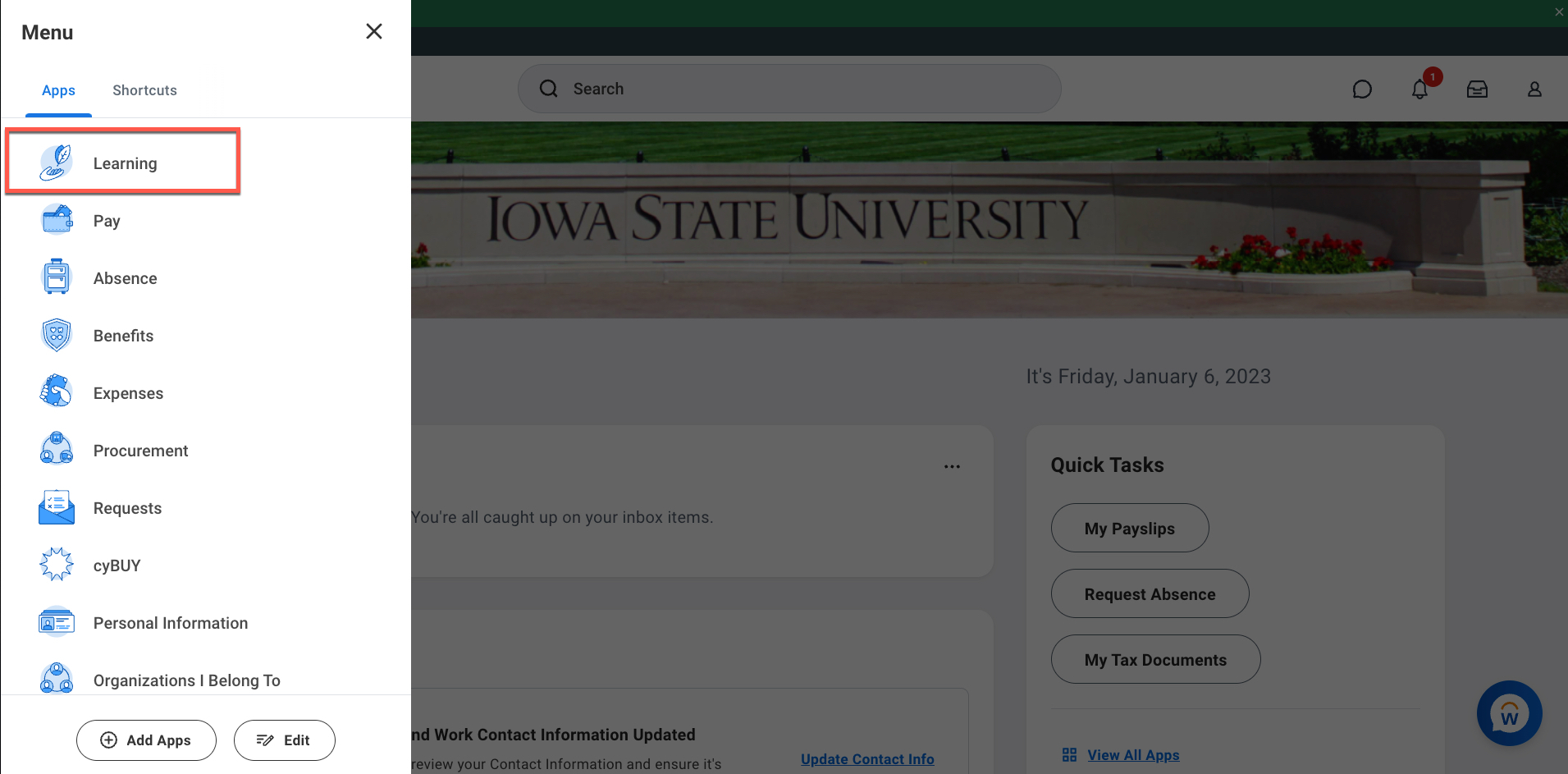
When employees log into Workday, a "Learning" app will be in the left menu list with familiar apps like pay, absence and benefits.
Workday Learning went live Jan. 23 and will replace Learn@ISU in September. Learn@ISU serves faculty, staff and hourly students, but Workday Learning is for faculty, staff and hourly student employees only. This past fall, training required for students enrolled in academic courses was moved to Canvas, ISU's learning management system.
Workday Learning's rollout is phased with 34 offerings available on the first day, including university compliance-related training like Title IX and free speech and university human resources (UHR) online options. Additionally, over 9,000 LinkedIn Learning courses will be available. More than 20 units across campus will review their learning content from Learn@ISU before moving content from one system to the other.
"We are giving units time to really go through their training and make needed updates in order to make sure what they put in Workday Learning is their most current content," UHR learning and development specialist Steve Couchman said.
New trainings added to Workday Learning will be announced through WorkCyte Digest and on the WorkCyte webpage throughout the year.
Using Workday Learning
Workday Learning lets supervisors assign training and review their employees' progress. It also provides better reporting options and easier access to professional development than Learn@ISU.
"Employees will have access to more than 9,000 courses in LinkedIn Learning that will show up on their learning transcript within Workday Learning," Couchman said.
If employees do not want their LinkedIn Learning courses to show on their learning transcripts, they may access LinkedIn Learning from their Okta tile.
LinkedIn Learning offers 24/7 professional development, skill-building, and training of all sorts. An easily accessible record of training and accomplishments for employees and supervisors is not available in Learn@ISU.
Numerous Workday Learning knowledge base articles are available through the Service Now Portal. Couchman said there are nine video-based tutorials that are one minute or less, and several one-page quick-reference guides to navigate the new system. Those with additional questions can email uhrlearn@iastate.edu.
Learn@ISU
Environmental Health and Safety (EHS) staff began using Learn@ISU for their training in 2011 before collaborating with UHR to make it universitywide in 2015. This collaboration grew from only EHS and UHR to over 30 departments and units using Learn@ISU and allowed for more learning opportunities on campus for faculty and staff. EHS has the license for Learn@ISU but will not renew it after September.
Senators see early results of student retention efforts
Senators received an update on the early impact of student retention efforts during fall semester at the Faculty Senate's Jan. 24 meeting.
Student success and retention is one of President Wendy Wintersteen's nine jump-start projects for the 2022-31 strategic plan. The three-year project received $1.5 million to increase graduation rates and help students at risk of leaving Iowa State, including those who are first generation, multicultural and are significantly impacted by the pandemic.
The Academic Success Center (ASC) received $150,000 for supplemental instruction and tutoring. Colleges also received $150,000 to expand tutoring and help rooms, especially for classes with high D, F and withdrawal rates, said Andrea Wheeler, faculty fellow for student success in the office of the senior vice president and provost.
ASC director Adriana Gonzalez-Elliott said money was used to increase the number of undergraduate tutors by improving pay to $15 an hour. Supplemental instructors also were added to a 100-level economics and math course at the midpoint of the semester. Students who attended the supplemental instruction sessions in the economics course had an average grade of 3.02 compared to 2.73 for those who did not. In the math course, the difference was 2.84 to 2.58.
Since becoming ASC director in the fall, Gonzalez-Elliott increased the size of tutoring groups from five to eight for high-demand courses. The center also partners with colleges to assist in help room trainings and developed the academic success navigator.
"It is an intake unit," Gonzalez-Elliott said. "I hope it alleviates the burden on campus to know the ins and outs of our services. The only expectation is for anyone meeting with a student who is unsure of what they need or where to begin, they can be referred here. It provides an individualized approach to connect students to resources at the center and across campus."
Wheeler also provided numerous examples of efforts at the college level that included peer-mentoring, tutoring and matching funds to increase support. She said a working group made up of unit directors, advisors and faculty has been formed to implement initiatives and help develop retention plans across campus.
Artificial intelligence
Associate provost for academic programs Ann Marie VanDerZanden spoke about the increased use of artificial intelligence, specifically ChatGPT, by students and how faculty may choose to address it. ChatGPT, the latest example of artificial intelligence (AI) capable of producing human-like text, can be used to write papers, develop art and write computer code among other tasks. It is different from previous chatbots because it can answer questions without being explicitly told the answer using its own intellect.
"It is the latest example of artificial intelligence that is not only impacting higher ed, but essentially every sector we can think of," she said.
VanDerZanden said a group has been formed with members from across campus to develop a document to aid faculty that includes syllabus recommendations.
"It would tell the students when AI is strictly prohibited, when AI might be allowed with attribution, when AI is encouraged with some tasks and when it might be something you incorporate in your pedagogy," she said.
VanDerZanden said faculty will be provided with a list of the most recent technology used to detect when AI is used, but cautioned that the information becomes outdated almost as fast as it is developed.
To prevent student use of AI, faculty may consider how they test students' knowledge. Oral exams, debates or, in an extreme case, returning to handwritten blue book exams.
"Don't hide from it and let the students know you are aware of it," she said.
Elections
Rahul Parsa (finance) was voted the next president-elect. He will take office in May, when president Jon Perkins (accounting) passes the gavel to president-elect Sarah Bennett-George (apparel, events and hospitality management).
Tim Bigelow (electrical and computer engineering) was elected chair of the resource policies and allocations council. He will serve as chair for the remainder of the spring semester, replacing Mikesch Muecke (architecture), who resigned his senate seat Dec. 31. Another election will be held later this spring to elect a new chair.
Other business
Senators approved:
-
A bachelor's degree in agricultural communication in the College of Agriculture and Life Sciences. The 128-credit major prepares graduates to communicate science, policy and technology in ag production to numerous audiences.
-
A professional master of business administration in the Ivy College of Business. The part-time graduate program is aimed at working adults and features a hybrid format with weekly in-person classes at the Capital Square Des Moines campus. Electives can be taken in Ames, Des Moines or online.
-
An asynchronous online master of accounting analytics in the Ivy College of Business. It prepares students for professional certification or licensure. This first-of-its-kind master in the state takes two semesters for full-time students and four for part-time.
- Numerous changes to the degree planning policy for majors, minors and certificates. Key changes include eliminating the required 30 additional credits above the degree or major requiring the most credits, with exceptions for the Business and Engineering colleges, and modifying the makeup and eligibility of credits for minors and certificates.
Yearlong freeze for university catalog begins Feb. 1
The task of moving student-related data from multiple legacy systems into Workday is so vast -- and so important -- that Iowa State will take the unusual step of pausing edits to the university catalog for about a year to help get it done. (The pause applies to Graduate College Handbook content, too.)
At the conclusion of its annual updating and editing process, on Feb. 1 the newest university catalog, for the 2023-24 academic year, will be frozen, in essence becoming the official record through the 2024-25 academic year. Generally, no new programs, changes to existing programs or changes to academic policies are permitted until next year about this time.
The freeze provides stability to a period when legacy systems (such as AccessPlus, ADIN) and Workday will both be in use but the focus will be on building and maintaining the future system. It gives staff involved in Workday Student time to develop the new system and confidence that data being moved from the old systems is reliable, said Ann Marie VanDerZanden, associate provost for academic programs.
"This creates a window when we don't have two parallel systems working, which reduces the opportunities for errors. We need to have a cut-over point, when we can assure accuracy of all the data at the time of transfer," VanDerZanden said.
Course, degree development continues
The freeze doesn't mean that change halts. The behind-the-scenes work that goes into creating courses and adding new degree programs will continue, VanDerZanden said. For example, work on two current initiatives, Degrees of the Future (to meet employer and student demand) and courses to meet the university’s new U.S. diversity requirements, will continue with a target launch in fall 2025. From department proposal to final approval by the state Board of Regents, it takes 12-18 months to add a degree program, she noted.
Next February, when work resumes on the catalog for the 2025-26 academic year, all necessary edits from the stabilization period will be made in the new Workday system.
It's a big catalog
The simple-sounding "university catalog" is a little misleading. In addition to a list of nearly 5,000 undergraduate and graduate courses organized alphabetically by major, minor or certificate, the university catalog includes all academic procedures and policies, curriculum requirements, first-year courses of study for more than 100 undergraduate majors, and the many layers of tuition assessment and financial aid possibilities.
Data storage solution: Google Photos to be turned off June 1
As part of the strategy to reduce the university's overall data storage in Google, Iowa State has chosen to turn off the Google Photos service in the university account June 1 to prevent individuals from quickly or unknowingly exceeding their storage quota. Faculty and staff should empty the Google Photos folder associated with their university account by then.
Photos count toward the total data storage in each individual account, which are capped at 3 gigabytes (GB), as of Jan. 3. Currently, Google Photos accounts for 16 terabytes (TB) in the university's overall 140 TB of stored data. Google set Iowa State's storage limit at 100 TB, with the penalty of defaulting the university account to read-only mode for exceeding the limit.
A limited number of employees need to store work-related photos in a university Google Photos account, and an exemption request form to keep Google Photos is available for them, said Jason Shuck, who manages the systems operations team in information technology services (ITS), which oversees data storage. Multiple employees can be included in a single request. Even for those approved to continue using Google Photos, the 3 GB individual cap remains in place.
Personal photos shouldn't be stored in a university account, he noted, though employees with Android phones may not be aware their phones automatically back up their photos and videos to Google Photos when they sign into their university Google account on their personal devices. With phone cameras capable of higher and higher resolutions and regular backup occurring, it doesn't take long to hit the 3 GB ceiling, Shuck noted.
"We're shutting off one avenue -- which lets native apps integrate as they're designed to do -- to help users control their Google storage," he said. "Otherwise, with the new cameras, this could get away from us quickly."
Another way Android users can protect their Google storage limit is to disable the photos/video backup function in Google. The best deterrent is to not log in to your ISU Google account on a personal device, Shuck said.
Why June 1?
Shuck said Google treats photos as personal property, so system administrators don't have access to other individuals' photos. Shuck's team can't delete or retrieve photos. ISU employees and students need to delete files from their own accounts, to benefit both the university and themselves. When Iowa State turns off Google Photos in most university accounts June 1, photos and videos left in accounts will stay forever -- and count against the individual 3 GB storage quota and the institutional 100 TB quota for as long as the account exists.
"We want to give people time to get their images and videos out, so we thought end of the semester is a fair amount of time," Shuck said. A knowledge base article in the IT portal provides instructions for deleting image files.
Once the app is turned off, the images stored there are inaccessible, Shuck said. There is no "view only" option in Google Photos.
Learn more
These knowledge base articles in the IT portal may be useful:
- Google Photos: Delete Photos/Videos
- Google Photos: Disable Photos/Videos Backup
- Google Drive: Export your Google Drive Content
